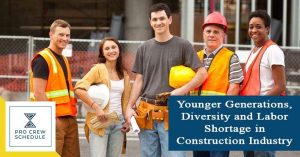The construction industry’s shortage was even shorter in the year 2021.
U.S. Bureau of Labor Statistics revealed that more than 47 million workers quit their jobs from April to December 2021. Some of the employees retired, but most switched jobs leaving low-wage industries such as healthcare and food services for higher pay, and millions remain on the sidelines dealing with their health or childcare concerns.
The surge in migrating families comes as no surprise as well. Many employees wanted to jump the domestic fences for years because of the hustle-culture that leaves many people drained for a long time. A worldwide poll by Gallup has shown that out of the one billion full-time workers around the globe, only 15% of people are engaged in their work. That means that 85% of workers are unhappy in their jobs. For underemployed and unhappy workers, a strong job market looks as tempting as ever before.
The millions of workers left on the sidelines will eventually re-enter the market after taking a break from many years of running in the rat race. The main concern now is how will the construction industry handle the return of the old employees and the introduction of fresh faces into the workforce? How can employee diversity be upheld in these changing times? And lastly, how can we empower the next generation in a traditional industry like construction?
Let’s discuss more it below.
Re-shaping the Workforce Development in Construction Industry
One of the construction management improvements that are of primary concern in this “Great Resignation” age is changing how we recruit our workers. In a traditional setting, there are three main ways the construction industry enforces workforce development: recruiting, retaining, and training employees of today and future employees.
Currently, this responsibility is given to the Human Resource department, but the world is changing. What most companies know about workforce development in the past won’t work in the current time anymore.
The Impact of Diversity in Construction Setting
Inclusion, diversity, and equity (IDE) are among the leading trends in construction management in workforce development. For older generations, a commitment to a diverse workforce- especially in an industry dominated by men- has never been taken seriously. However, the newer generations are more aware and passionate about the importance of diversity and inclusion in the workplace.
Construction is not only a place for men; women are also given the same respect. Color and gender are now overlooked, and people are welcomed as they are. Further improving these IDE practices will surely be a critical component in guiding leaders on how to lead successful employees in their respective workplaces.
Practical Construction Workplace Improvements You Can Incorporate
1. Conduct assessments to recognize the gaps in practices and attitudes to identify the “frozen middle” of the company where nothing changes.
2. Adapt leadership development and coaching principles to break the frozen middle, change old workflows and renew the organization’s commitments to their respective teams—and each member’s commitments to each other.
3. Merge IDE programs into the routines of the everyday team and managerial-level decision-making and overall company operations.
It’s up to construction leadership to show that they prioritize employee retention, IDE, and wellness and demonstrate to the organization that they genuinely care.
The Next Generation of Construction Professionals
With the prevalent “Great Resignation” that is being experienced by many industries, it doesn’t come as a surprise for the construction industry. In fact, in skilled trades, the shortage of incoming workers has long been a challenge.
The labor shortage is reaching a
critical level as skilled trades workers retires at a five to one ratio than the new labor entering the field, with plumbers, electricians, and construction workers being the most impacted fields. However, this setback presents ample opportunity for the new generation looking to break into the profession.
The construction industry has an unprecedented opportunity to attract up-and-coming and skilled talent. With job security, professional construction careers come with high starting-salaries and job satisfaction.
Career paths in the skilled construction trades include, but are not limited to:
- Carpenters
- Brick masons
- Electricians
- Plumbers
- HVAC technicians
Moreover, career paths in the building safety industry comprise, but are not limited to:
- Building officials
- Fire marshals
- Code enforcement officers
- Mechanical examiners
- Plumping inspectors
- Permit inspectors
To truly capitalize on this shift in the industry, companies across the construction must be ready to educate, advocate and provide resources for employees who want to explore their career options.
Ways to Engage the Younger Generation in the Workplace
1. Boost Hiring Efforts… Online
Incorporating digital construction tools to attract younger talents is now more vital than ever. The new generations, especially Gen Z’s, are constantly on social media and the web, showing that the easiest way to get the attention of this workforce is by meeting them where they are- online. Millennials and Gen Z’s personas are tied to their online lives. These younger people expect new, streamlined solutions that eliminate tedious and manual application processes. Construction companies must re-evaluate job openings and online branding to reach this distinct audience.
2. Prioritize Safety, Especially on Jobsites
According to the U.S. Bureau of Labor Statistics, around 20% of deaths in the workplace across all industries are within the construction industry. Because of this, safety technologies and innovations are attractive to young people not only because of their modern factor but also because of their proven efficiency.
Exoskeleton PPE and suits, which seem to have come from futuristic movies, help protect the one wearing them from injury and reduce possible fatalities when operating heavy equipment.
3. Implement Construction Software in Your Operations
When you make construction technology integral to the company operations, you convey to your employees that you care deeply about efficiency. Conventional processes can now be performed faster (and some remotely) with the help of technology.
Furthermore, investing in construction tools will engage more of your younger employees. Construction software is designed specifically for the industry and thus, provides unique advantages. It certainly empowers your fresh talents to work more productively over time. When you incorporate specialized software like Pro Crew Schedule, your employees will experience the following features:
- Achievable targets
- Task and goal visibility
- Real-time communication and collaboration
- Unified workflow and faster notifications
- Accessible anytime and anywhere
- Online storage for construction data and files
4. Invest in More Advanced Heavy Equipment
The construction industry is constantly evolving with the use of technology. Upgrading heavy equipment and tools to complete construction faster allows new talents to operate equipment even with basic training. With modern and more advanced machines at your disposal, it is easier to manage and saves time and cost.
Moreover, remote technology helps monitor the safety and use of vehicles and equipment. Not only will investing in heavy equipment help your company in the long run, but it will also streamline your construction equipment management.
5. Supportive Company Culture
Younger generations want to be reassured and validated that their job is essential and that their employers value them. Mentoring, coaching, and giving feedback to young professionals shows your appreciation and belief in their abilities. Furthermore, they want to contribute to the success of their organization directly.
Always allow your younger recruits to voice their unique solutions and recognize their successes and wins. Linking Millennials and Gen Z’ with more experienced employees can do the trick, and this will show them that you care about what they are learning and guide their development.
Retaining Construction Talents in the Workplace
Ultimately, Gen Z and Millennials are motivated to work for a company that stands for a deeper purpose beyond making a profit. They crave their work to make a positive societal and environmental impact. A career in the construction industry provides opportunities that will cultivate these yearnings as these professions ensure that communities continue to be structurally safe, sustainable, resilient, and accessible to all.
Motivated and well-trained construction professionals are fundamental to creating and maintaining a thriving environment. As the construction industry looks toward the new generation to fill the ranks, companies must step up to provide guidance, resources, and assistance to help employees understand the benefits of pursuing a career in construction.
Key Takeaway
Advancements in construction technology can help companies attract—and retain—the younger generation of workers. This fresh breed will replace the retiring workforce and bring to the industry a new perspective.
By switching and rethinking recruitment efforts to meet Gen Z and Millennials where they are, companies can be more successful in their hunt for skilled talents. Aside from making the construction industry attractive to young people, technology can improve safety and efficiency in operations. Making these critical changes shouldn’t be too daunting when you know that you have construction tools designed for all generations that can help you attract, train and retain them.







